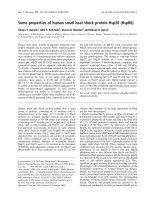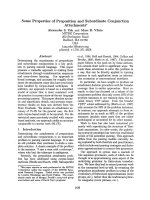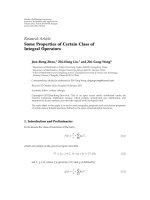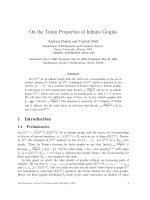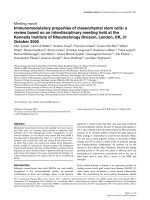Some properties of As-doped silicene nanoribbons: A DFT study
Bạn đang xem bản rút gọn của tài liệu. Xem và tải ngay bản đầy đủ của tài liệu tại đây (1006.08 KB, 14 trang )
Some properties of As-doped silicene nanoribbons: A DFT study
Phan Thi Thuy Linh1*, Nguyen Phuc Nhan1, Luu Thuy Trang1,
Vuong Ngoc Anh Dai1, Hoang Van Ngoc1
1
Insitute of Applied Technology, Thu Dau Mot University, Binh Duong province, Vietnam
* Coressponding:
ABSTRACT. As the counterpart of graphene, silicene becomes a hot spot in low-dimension
material application after being recently grown on different metal-lic surfaces. Silicene has a
low bumpy hexagonal lattice structure with sp2/sp3 mixed orbital hybridization in Si-Si bonds.
Limiting the quantum size of silicene is a simple and efficient method to extend the bandgap for
silicene while keeping the low undulation honeycomb lattice. The finite size limitation of 2D
silicene can produce 1D silicene nanoribbons (SiNR). This study used the Density functional
method (DFT) and VASP software to investigate some properties of the structure of silicene
nanoribbons after doping asen. There are six structures studied including top, valley, ortho,
meta, para and 100% configurations. This work creates new materials for application in science
and technology in the future.
KEYWORDS: Silicene nanoribbons, As-doped silicene, doped structure, doping configurations.
1. Introduction
A new era of low-dimensional materials science has been ushered in since two-dimensional
monolayer (2D) graphite structures were successfully synthesized by Greim and Novoselov by
mechanical analysis in 2004 [1-3]. This first 2D monolayer graphite system is widely known as
graphene. Graphene is made up of hybridized carbon (C) atoms on sp2 orbitals and arranged in a
highly symmetric planar hexagonal lattice [4]. The honeycomb lattice structure of graphene can
be extended to produce different C allotropes, where graphene can be stacked to form 3D
graphite [5], curled to form nano carbon (1D) [6], was cut to form 1D nano carbon [7] and 3D
bent to form a 0D fullerene bridge structure [8]. The mechanism of orbital hybridization in
graphene is that the C-(2s, 2px, and 2py) are hybridized to form stable bonds to form a planar 2D
structure, and the C-2pz orbitals remain in the state freely form weak π bonds along the zdirection. This demonstrates that the σ and π bonds in graphene are clearly separated, with the π
orbitals mainly contributing to the Dirac cone structure in the low energy region near the Fermi
level [9]. π-conjugation in the wide energy range of graphene produces many new physical
properties that have been of interest in many recent studies [10]. To date, graphene has been used
in various high-performance applications. However, the zero frequency band of graphene limits
the application potential of graphene for nano-electronic applications. To overcome the
unfavorable properties of graphene, various methods have been used to widen the bandgap in
graphene including surface functionalization [11], atomic doping [12], mechanical strain [13],
layered configuration [14], finite-size limitation [15], defect generation [16], and applied external
107
electric field [17]. After graphene, much research effort has been focused on graphene-like
monoatomic 2D materials such as silicene [18], germanene [19], stanene [20], phosphorene [21],
antimonide [22],... Where silicene, a 2D graphene-like structure, is made up of silicon atoms
arranged in a bumpy honeycomb lattice structure. Silience possesses many new physical
properties such as graphene [23]; however, silicene exhibits better compatibility in silicon
element-based electronic devices than graphene, so silicene has attracted much research to
deploy its potential for practical applications [24]. Unlike graphene, silicene can only be
synthesized through bottom-up epitaxial growing methods because silicon atoms do not have a
3D layered structure like graphite. The most common method for synthesizing silicene
monolayers is the deposition of silicon atoms on metal substrates [25-27]. The successful
experimental synthesis of silicene monolayers provided experimental evidence for the theoretical
predictions of the existence of silicene in 1994 [28]. To date, silicene has been deployed in many
applications including room-temperature field-effect transistors (FETs) [29], gas sensors [30],
and batteries [31].
However, the very small bandgap energy of silicene has shown many disadvantages to
deploying silicene in electronic devices [32]. Therefore, a lot of research has been done to extend
the bandgap for silicene including chemical change [33], quantum limit [34], layered
configuration [35], mechanical strains study [36], and apply to external schools [37]. Among
these methods, limiting the quantum size of silicene is a simple and effective method to extend
the bandgap for silicene while keeping the low undulation honeycomb lattice. The finite size
limitation of 2D silicene can produce 1D silicene nano bands (SiNR) with the armchair edge
(ASiNR) and zigzag (ZSiNR) forms [38]. SiNR with enhanced bandgap energy can completely
overcome the main obstacle of silicene for electronic devices [39]. Experimentally, SiNR has
been successfully synthesized from both top-down and bottom-up methods. The top-down
method is to cut 2D silicene sheets to form 1D nano silicene [40], while the bottom-up method is
to epitaxially grow 1D nano silicene on metal substrates or insulating thin films [41]. SiNRs with
their outstanding novel physical properties and their good compatibility in silicon-based
electronic devices have attracted much interest in the scientific community recently [42]. On the
other hand, various applications require materials with more diverse physical properties such as
large bandgap energies for semiconductors or optoelectronic applications.
Therefore, diversifying the essential physical properties of 1D silicene nanoribbons to suit
various applications is an important issue for science and technology. Various methods have
been used to diversify the essential physical properties of 1D silicene nanoribbons including
chemical doping [43], passivation of edges [44], layered configurations [43], passivation [44],
layered configuration [45], creating lattice defects [46], applying external fields [47] and forming
heterostructures; Among these methods, the doping method is currently receiving a lot of
attention from researchers both at home and abroad. Therefore, we focus on studying some
properties of Silence Nanoribbons when doped with As in the hope of creating new materials for
application in science and engineering.
108
2. Research Methods
In this work, we use density functional theory (DFT) to study and VASP software to simulate
materials.Density functional theory (DFT) is a theory used to describe the properties of electron
systems in atoms, molecules, solids,... within the framework of quantum theory. In this theory,
the properties of the N-electron system are expressed as a function of the electron density of the
entire system (which is a function of 3 spatial coordinate variables) instead of a wave function
(which is a function of 3N spatial coordinate variables). Therefore, density function theory has a
great advantage (and is currently the most used) in computing the physical properties for
particular systems from the very basic equations of quantum physics death.
VASP (Vienna Ab Initio Simulation Packages): is a computer program for simulating materials
at atomic size. First, VASP was developed by Mike Payne (MIT). The VASP was then brought
by Jurgen Hafner to the University of Vienna in Austria in 1989. The main program of VASP is
written by Jurgen Furthmuller. Jurgen Furthmuller and Georg Kresse joined Institut fur
Materialphysik in 1993. Currently, VASP is being developed by Georg Kresse, recent additions
include the development of methods commonly used in molecular quantum chemistry to periodic
systems. VASP has been used by more than 1400 research groups on the basis of a license
agreement with the University of Vienna.
3. Results and Discussions
3.1. Doped configurations
Fig. 1a shows the pristine undoped configuration of a silicene nanoribbons unit cell; Fig. 1b
1c in the order of top and valley structures with only 1 doped atom; Fig. 1d 1e 1f in order the
meta, ortho, and para structures all have 2 doped atoms; Fig. 1g is a 100% configuration with 6
doped atoms.
Table 1. The formation energy of the doping configurations
Systems
E0t(eV)
E0p(eV)
E0Si (eV)
E0As(eV)
ΔEf
Ortho
-70.218542
-69.408218
-0.1353442
0.09662854
0.88775532
Meta
-69.795159
-69.408218
-0.1353442
0.09662854
0.46437232
Para
-69.991258
-69.408218
-0.1353442
0.09662854
0.66047132
100%
-70.866743
-69.408218
-0.1353442
0.09662854
1.69081896
109
Top
-69.866698
-69.408218
-0.1353442
0.09662854
0.49719566
Valley
-69.783293
-69.408218
-0.1353442
0.09662854
0.41379066
The formation energy [48]: ΔEf = Et – Ep + n*ESi – n*EAs
(1)
E0t is the energy of the doping system; E0p is the energy of the pristine system; E0si is the
energy of the free Si atom; E0As is the energy of the free As atom; ΔEf is the formation energy of
the doping configurations. The 100% configuration gives the smallest formation energy, so this
is the most stable and optimal configuration.
Fig 1. Top view of the configurations of silicene nanoribbons when doped with asen
(a) pristine ; (b) top; (c) valley; (d) meta; (e) ortho; (f) para; (g) 100%
Fig 2. Side view of the configurations of silicene nanoribbons when doped with asen
110
(a) pristine ; (b) top; (c) valley; (d) meta; (e) ortho; (f) para; (g) 100%
Fig. 2 shows side views of the pristine, top, valley, meta, ortho, para, and 100%
configurations. Looking at the image, we can see the warping of silicene nanoribbons before and
after doping.
3.2. Energy band structure and state density
Fig. 3(a) show the original configuration of silicene nanoribbons has a band gap of 0.4eV and
this is a semiconductor. Fig. 3(b) show after doping an As atom for silicene nanoribbons, the top
configuration has no band gap because the fermium-level cutting energy bands go from the
valence band to the conduction band, so this is a semi-metallic structure.
Fig. 4(a) show after doping an As atom for silicene nanoribbons, the valley configuration has
no bandgap because the fermium-level shear bands go from the valence band to the conduction
band, so it is a semi-metallic structure. And the meta configuration after doping two As atoms
shows a bandgap of 0.44eV, so this is a semiconductor. Compared with pristine configuration,
the bandgap is wider than 0.04eV, so the meta configuration can be applied in semiconductor
devices flexibly. Fig. 4(b) show after doping an As atom for silicene nanoribbons, the valley
configuration has no band gap because the fermium-level shear bands go from the valence band
to the conduction band, so it is a semi-metallic structure. And the meta configuration after
doping two As atoms shows a bandgap of 0.44eV, so this is a semiconductor. Compared with
pristine configuration, the bandgap is wider than 0.04eV, so the meta configuration can be
applied in semiconductor devices flexibly.
Fig. 3. Energy band structure (left), state density (right) of the pristine configuration (a)
and top configuration (b)
111
Fig 4. Energy band structure (left), state density (right) of the valley configuration (a)
and meta configuration (b)
Fig 5. Energy band structure (left), state density (right) of the ortho configuration (a)
and para configuration (b)
Fig. 5 show after doping two As atoms for silicene nanoribbons, the ortho and para
configurations are both semiconductors when the ortho configuration has a bandgap of 0.34eV
narrower than the pristine configuration of 0.07eV; The para configuration has a bandgap of
0.91eV and is wider than the pristine configuration of 0.51eV, so the para configuration can be
applied very well in flexible semiconductor devices.
112
Fig 6. Energy band structure (left), state density (right) of the 100% configuration (a) and the
contribution of Si(s), Si(p) partial states of the pristine configuration (b)
Fig. 6(a) show after doping six As atoms for silicene nanoribbons, the 100% configuration has
a zero band gap, which is a semiconductor. Around the Fermi level is the most concentrated
states. Fig. 6(b) show the blue line is the Si(s) states of the silicon atom, and the red line
corresponds to the Si(p) states of the silicon atom. Si(s) is located at the bottom of the valence
band and the top of the conduction band, while the Si(p) states are concentrated mainly at the top
of the valence band and the bottom of the conduction band (around the Fermi level). The peak of
the highest state (p) of the pristine configuration corresponds to an energy level of ~ -1.8eV. The
peak of the highest Si(s) state of the pristine configuration corresponds to an energy level of ~9eV.
Fig 7. The contribution of Si(s), Si(p) partial states of the top configuration (a)
and valley configuration (b)
Fig. 7(a), the peak of the highest Si(p) state of the top configuration corresponds to an energy
level of ~-2.6eV, shifting 0.8eV in the negative direction relative to the pristine configuration.
The peak of the highest Si(s) state of the top configuration corresponds to an energy level of ~113
10eV, shifting 1eV in the negative direction compared to the pristine configuration. For Fig. 7(b)
the peak of the highest Si(p) state of the valley corresponds to an energy of ~-2.5eV, shifting
0.7eV in the negative direction relative to the pristine configuration. The peak of the highest
Si(s) state of the valley corresponds to an energy level of ~-9.6eV, shifting 0.6eV in the negative
direction relative to the pristine configuration.
The contribution of the Si(p) state of the valley configuration in the formation of the energy band
structure is the largest compared to the remaining configurations.
Fig 8. The contribution of Si(s), Si(p) partial states of the meta configuration (a)
and ortho configuration (b)
For Fig. 8(a), the peak of the highest Si(p) state of the meta configuration corresponds to an
energy level of ~ -2.3eV, shifting 0.5eV in the negative direction compared to the pristine
configuration. The peak of the highest Si(s) state of the meta configuration corresponds to an
energy level of ~-9.8eV, shifting 0.8eV in the negative direction compared to the pristine
configuration. For fig 8(b), the peak of the highest Si(p) state of the ortho configuration
corresponds to an energy level of ~-2.3eV, shifting 0.5eV in the negative direction relative to the
pristine configuration. The peak of the highest Si(s) state of the ortho configuration corresponds
to an energy level of ~-9.1eV, shifting 0.1eV in the negative direction compared to the pristine
configuration.
114
Fig 9. The contribution of Si(s), Si(p) partial states of the para configuration (a)
and 100% configuration (b)
For Fig. 9(a), the peak of the highest Si(p) state of the para configuration corresponds to an
energy level of ~-2.8eV, shifting 1eV in the negative direction relative to the pristine
configuration. The peak of the highest Si(s) state of the para configuration corresponds to an
energy level of ~-9eV, which is unchanged from the pristine configuration. For Fig. 9(b), the
peak of the highest Si(p) state of the 100% configuration corresponds to an energy level of ~ 2.6eV, shifting 0.8eV in the negative direction relative to the pristine configuration. The peak of
the highest Si(s) state of the 100% configuration corresponds to an energy level of ~ -8.9eV,
shifting 0.1eV towards the positive direction compared to the pristine configuration.
The contribution of the Si(s) state of the para configuration in the formation of the energy
band structure is the largest compared to the remaining configurations.
Fig 10. The contribution of As(s), As(p) partial states of the top configuration (a)
and valley configuration (b)
For Fig. 10(a), the peak of the highest As(p) state of the top configuration corresponds to an
energy level of ~ -3.5eV. The peak of the highest As(s) state of the top configuration corresponds
to an energy level of ~-7.7eV. For Fig. 10(b), the peak of the highest As(p) state of the valley
115
configuration corresponds to an energy level of ~-3eV. The peak of the highest Si(s) state of the
valley configuration corresponds to an energy level of ~-7.8eV.
Fig 11. The contribution of As(s), As(p) partial states of the meta configuration (a)
and ortho configuration (b)
For Fig. 11(a), the peak of the As(p) state is the highest of the meta-configuration with an
energy level of ~-2.3eV. The peak of the highest As(s) state of the meta-configuration
corresponding to the energy level is ~-9.9eV. For Fig. 11(b), the peak of the highest As(p) state
of the ortho configuration corresponds to an energy level of ~-4.3eV. The peak of the highest
Si(s) state of the ortho configuration corresponds to an energy level of ~-8.8eV.
For Fig. 12(a) the peak of the highest As(p) state of the para configuration corresponds to an
energy level of ~ -3.4eV. The peak of the highest As(s) state of the para configuration
corresponds to an energy level of ~-8.2eV. For Fig. 12(b) the peak of the highest As(p) state of
the 100% configuration corresponds to an energy level of ~ -2.5eV. The peak of the highest Si(s)
state of the 100% configuration corresponds to an energy level of ~-5.2eV.
The contribution of the As(p) state of the 100% configuration in the formation of the energy
band structure is the largest compared to the remaining configurations.
116
Fig 12. The contribution of As(s), As(p) partial states of the para configuration (a)
and 100% configuration (b)
4. Conclusions
The work studies some properties of silicene nanoribbons when doped with As in the hope of
creating new materials for application in science and technology. There are 6 studied structures
including top, valley, meta, ortho, para, 100% conclusions.
The original configuration of silicene nanoribbons has a bandgap of 0.4eV and this is a
semiconductor. After doping an As atom for silicene nanoribbons, the top and valley
configurations are semi-metallic because there is no band gap due to the fermium-level shear
bands going from the valence band to the conduction band. After doping two As atoms for
silicene nanoribbons, the meta, ortho, and para configurations are all semiconductors. Meta and
para configurations have a wider extension than pristine configurations, which can be used very
well in flexible semiconductor devices. After doping six As atoms for silicene nanoribbons, the
100% configuration has a zero bandgap, which is a semiconductor. Around the Fermi level is the
most concentrated state.
The contribution of the Si(p) state of the valley configuration in the formation of the energy
band structure is the largest compared to the remaining configurations. The contribution of the
Si(s) state of the para configuration in the formation of the energy band structure is the largest
compared to the remaining configurations. The contribution of the As(p) state of the 100%
configuration in the formation of the energy band structure is the largest compared to the
remaining configurations.
Acknowledgments
This research used resources of the high-performance computer cluster (HPCC) at Thu Dau
Mot University (TDMU), Binh Duong Province, Vietnam.
117
References
[1] Novoselov K S et al., Electric field effect in atomically thin carbon films, Science. 306,
666-669, 2004.
[2] Geim A K, Graphene prehistory, Physica Scripta. 146, 14003, 2012.
[3] Novoselov K S et al., Two-dimensional gas of massless Dirac fermions in graphene,
Nature. 438, 197-200, 2005.
[4] Zhang C and Liu T, A review on hybridization modification of graphene and its polymer
nanocomposites, Chinese Sci. Bull. 57, 3010–21, 2012.
[5] Ahuja R, Auluck S, Trygg J, Wills J M, Eriksson O and Johansson B, Electronic
structure of graphite: effect of hydrostatic pressure, Phys. Rev B.51, 4813, 1995.
[6] Li K et al., Self-assembly of graphene on carbon nanotube surfaces, Sci. Rep. 3, 2353,
2013.
[7] Ren W, Gao L, Liu B, Zhao J and Cheng H-M, Efficient synthesis of graphene
nanoribbons sonochemically cut from graphene sheets Nano Res. 3, 16–22, 2010.
[8] Tang C, Oppenheim T, Tung V C and Martini A, Structure-stability relationships for
graphene- wrapped fullerene-coated carbon nanotubes, Carbon. 61, 458–66, 2013.
[9] Kariyado T and Hatsugai Y, Manipulation of Dirac Cones in mechanical graphene,
Sci.Rep. 5, 18107, 2015.
[10] Phiri J, Johansson L-S, Gane P and Maloney T, A comparative study of mechanical,
thermal and electrical properties of graphene-, graphene oxide- and reduced graphene
oxide-doped microfibrillated cellulose nanocomposites, Compos. Part B Eng. 147, 104–13, 2018.
[11] Xu X et al., Interfacial engineering in graphene band gap, Chem. Soc. Rev. 47, 305999, 2018.
[12] Fan X, Shen Z, Liu A Q and Kuo J-L, Band gap opening of graphene by doping small
boron nitride domains, Nanoscale. 4, 2157-65, 2012.
[13] Gui G, Li J and Zhong J, Band structure engineering of graphene by strain: firstprinciples calculations, Phys. Rev. B. 78 75435, 2008.
[14] Tang S, Wu W, Xie X, Li X and Gu J, Band gap opening of bilayer graphene by
graphene oxide support doping, RSC Adv. 7, 9862-71, 2017.
[15] Villamagua L, Carini M, Stashans A and Gomez C V, Band gap engineering of graphene
through quantum confinement and edge distortions, Ric. di Mat. 65, 579-84, 2016.
[16] Iyakutti K, Mathan Kumar E, Thapa R, Rajeswarapalanichamy R, Surya V J and
Kawazoe Y, Effect of multiple defects and substituted impurities on the band structure of
graphene: a DFT study, J. Mater. Sci. Mater. Electron. 27, 12669-79, 2016.
[17] Mak K F, Lui C H, Shan J and Heinz T F, Observation of an electric-field-induced band
gap in bilayer graphene by infrared spectroscopy, Phys. Rev. Lett. 102, 256405, 2009.
[18] Oughaddou H et al., Silicene, a promising new 2D material, Prog. Surf. Sci. 90, 46–83,
2015.
[19] Acun A et al., Germanene: the germanium analogue of graphene, J. Phys. Condens.
Matter. 27, 443002, 2015.
118
[20] Zhu F et al., Epitaxial growth of two-dimensional stanene, Nat. Mater. 14, 1020–5, 2015.
[21] Khandelwal A, Mani K, Karigerasi M H and Lahiri I, Phosphorene-the two-dimensional
black phosphorous: properties, synthesis and applications, Mater. Sci. Eng. B. 221, 17–34, 2017.
[22] Singh D, Gupta S K, Sonvane Y and Lukačević I, Antimonene: a monolayer material for
ultraviolet optical nanodevices, J. Mater. Chem. C. 4, 6386–90, 2016.
[23] Akbari E, Buntat Z, Afroozeh A, Pourmand S E, Farhang Y and Sanati P, Silicene and
graphene nanomaterials in gas sensing mechanism, RSC Adv. 6, 81647–53, 2016.
[24] Kharadi M A, Malik G F A, Khanday F A, Shah K A, Mittal S and Kaushik B K,
Reviewsilicene: from material to device applications, ECS J. Solid State Sci. Technol. 9, 115031,
2020
[25] Meng L et al., Buckled silicene formation on Ir(111), Nano Lett. 13, 685–90, 2013.
[26] Fleurence A, Friedlein R, Ozaki T, Kawai H, Wang Y and Yamada-Takamura Y,
Experimental evidence for epitaxial silicene on diboride thin films, Phys. Rev. Lett. 108, 245501,
2012.
[27] Vogt P et al., Silicene: compelling experimental evidence for graphene-like twodimensional silicon, Phys. Rev. Lett. 108, 155501, 2012.
[28] Takeda K and Shiraishi K, Theoretical possibility of stage corrugation in Si and Ge
analogs of graphite, Phys. Rev. B. 50, 14916, 1994.
[29] Lima M P, Fazzio A and Silva A J R da, Silicene-based FET for logical technology,
IEEE Electron Device Lett. 39, 1258–61, 2018.
[30] Aghaei S M, Monshi M M and Calizo I, A theoretical study of gas adsorption on silicene
nanoribbons and its application in a highly sensitive molecule sensor, RSC Adv. 6, 94417–28,
2016.
[31] Galashev A Y and Ivanichkina K A, Silicene anodes for lithium - ion batteries on metal
substrates, J. Electrochem. Soc. 167, 50510, 2020.
[32] Ni Z et al., Tunable band gap in silicene and germanene, Nano Lett. 12, 113, 2012.
[33] Nakano H, Tetsuka H, Spencer M J S and Morishita T, Chemical modification of group
IV graphene analogs, Sci. Technol. Adv. Mater. 19, 76–100, 2018.
[34] Mehdi Aghaei S and Calizo I, Band gap tuning of armchair silicene nanoribbons using
periodic hexagonal holes, J. Appl. Phys. 118, 104304, 2015.
[35] Lin S-Y, Liu H-Y, Nguyen D K, Tran N T T, Pham H D, Chang S-L, Lin C-Y and Lin
M-F, Stacking-configuration-enriched fundamental properties in bilayer silicenes, SiliceneBased Layer. Mater., 5–28, 2020.
[36] Jia T-T et al., Band gap on/off switching of silicene superlattice, J. Phys. Chem. C. 119,
20747, 2015.
[37] Drummond N D, Zólyomi V and Fal’ko V I, Electrically tunable band gap in silicene,
Phys. Rev. B. 85, 75423, 2012.
[38] Mehdi Aghaei S, Torres I and Calizo I, Structural stability of functionalized silicene
nanoribbons with normal, reconstructed, and hybrid edges, J. Nanomater., 5959162, 2016.
119
[39] Chuan M W, Wong K L, Hamzah A, Riyadi M A, Alias N E and Tan M L P, Electronic
properties of silicene nanoribbons using tight-binding approach, International Symposium on
Electronics and Smart Devices (ISESD), 1–4, 2019.
[40] De Padova P et al., Multilayer silicene nanoribbons, Nano Lett. 12, 5500, 2012.
[41] van den Broek B, Houssa M, Lu A, Pourtois G, Afanas’ev V and Stesmans A, Silicene
nanoribbons on transition metal dichalcogenide substrates: effects on electronic structure and
ballistic transport, Nano Res. 9, 3394–406, 2016.
[42] Li H et al., High performance silicene nanoribbon field effect transistors with current
saturation, Eur. Phys. J. B. 85, 274, 2012.
[43] Sarebanha B and Ahmadi S, Doping effect on spin dependent electron transport in zigzag
silicene nanoribbons, Procedia Mater. Sci. 11, 259–64, 2015.
[44] Yao Y, Liu A, Bai J, Zhang X and Wang R, Electronic structures of silicene
nanoribbons: two-edge-chemistry modification and first-principles study, Nanoscale Res. Lett.
11, 371, 2016.
[45] Deng X Q and Sheng R Q, Spin transport investigation of two type silicene nanoribbons
heterostructure, Phys. Lett. A, 383, 47–53, 2019.
[46] An R-L et al., Vacancy effects on electric and thermoelectric properties of zigzag silicene
nanoribbons, J. Phys. Chem. C. 118, 21339, 2014.
[47] Fang D Q, Zhang Y and Zhang S L, Silicane nanoribbons: electronic structure and
electric field modulation, New J. Phys. 16, 115006, 2014.
[48] Q. Pang, Y. Zhang, J. M. Zhang, V. Ji, and K. W. Xu, 2011, Electronic and magnetic
properties of pristine and chemically functionalized germanene nanoribbons, Nanoscale, Vol. 3
(10) p 4330-4338
120
